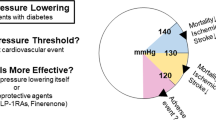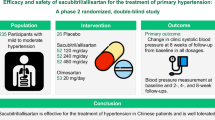Abstract
The impact of an ARB, with or without hydrochlorothiazide (HCTZ), on glycaemic factors and the risk for developing diabetes in hypertensive patients with the metabolic syndrome have not been fully assessed. This was a 52-week multicentre, prospective, phase-IV, open-label, cohort study of losartan or losartan/HCTZ in hypertensive patients with metabolic syndrome. All subjects were treated initially with losartan 50 mg day−1. Those not achieving target blood pressure (BP <140/90 mm Hg) were titrated sequentially to losartan 100 mg, losartan 100 mg/HCTZ 12.5 mg, losartan 100 mg/HCTZ 25 mg and finally to losartan 100 mg/HCTZ 25 mg and calcium-channel blocker (CCB), as required. The primary glycaemic outcome measure was change in fasting blood glucose (FBG) and glycosylated haemoglobin A1c (HbA1c) at 52 weeks of treatment. Among the 1897 potentially eligible patients enrolled in the study, 1714 fulfilled the screening criteria. During the 52-week treatment period of the study, FBG and HbA1c did not change significantly. Clinically important and statistically significant changes were observed for both the systolic (SBP) and diastolic BP (DBP) during the study treatment period, with an overall mean decrease of 16.95 mm Hg in SBP (P=0.001) and 9.84 mm Hg in DBP (P=0.001). The majority of the patients (77.3%) achieved a target BP of <140/90 mm Hg. In conclusion, losartan, either alone or in combination with HCTZ, is effective in managing hypertension without inducing any change in glycaemic parameters or increasing the risk for developing diabetes in hypertensive patients with the metabolic syndrome.
This is a preview of subscription content, access via your institution
Access options
Subscribe to this journal
Receive 12 digital issues and online access to articles
$119.00 per year
only $9.92 per issue
Buy this article
- Purchase on Springer Link
- Instant access to full article PDF
Prices may be subject to local taxes which are calculated during checkout


Similar content being viewed by others
References
Lemieux I, Pascot A, Prud′homme D, Alméras N, Bogaty P, Nadeau A et al. Elevated C-reactive protein: another component of the atherothrombotic profile of abdominal obesity. Arterioscler Thromb Vasc Biol 2001; 21: 961–967.
Landin K, Stigendal L, Eriksson E, Krotkiewski M, Risberg B, Tengborn L et al. Abdominal obesity is associated with an impaired fibrinolytic activity and elevated plasminogen activator inhibitor-1. Metabolism 1990; 39 (10): 1044–1048.
Lemieux I, Pascot A, Couillard C, Lamarche B, Tchernof A, Alméras N et al. Hypertriglyceridemic waist: a marker of the atherogenic metabolic triad (hyperinsulinemia; hyperapolipoprotein B; small, dense LDL) in men? Circulation 2001; 102 (2): 179–184.
Redon J, Martinez J, Fabia MJ . The metabolic syndrome in hypertension. Arch Med Sci 2009; 5, 2A S320–S329.
Health Canada. Canadian diabetes strategies. Internet site www.hc-sc.gc.ca.
World Health Organization. The diabetes program. Internet site www.who.int/diabetes/en.
Canadian Diabetes Association 2003 Clinical Practice Guidelines for the prevention management of diabetes in Canada. Can J Diabetes 2003; 27 (Suppl. 2): S1–S152.
Knowler WC, Barrett-Connor E, Fowler SE, Hamman RF, Lachin JM, Walker EA et al. Reduction of the incidence of type 2 diabetes with lifestyles intervention or metformin. N Engl J Med 2002; 346 (6): 393–403.
Tuomilehto J, Lindstrom J, Ericksson JG, Valle TT, Hämäläinen H, Ilanne-Parikka P et al. Prevention of type 2 diabetes mellitus by change in lifestyle among subjects with impaired glucose tolerance. N Engl J Med 2001; 344 (18): 1343–1350.
Dahlof B, Devereux RB, Kjeldsen SE . Cardiovascular morbidity mortality in the Losartan Intervention for Endpoint reduction in hypertension study (LIFE); a randomised trial against atenolol. Lancet 2002; 359: 995–1003.
Cheethman C, Collis J, O’Driscoll G, Stanton K, Taylor R, Green D . Losartan, an angiotensin type I receptor antagonist, improves endothelial function in non-insulin-dependant diabetes. J Am Coll Cardiol 2000; 36 (5): 1461–1466.
Arase Y, Suzuki F, Suzuki Y, Akuta N, Kobayashi M, Kawamura Y et al. Losartan reduces the onset of type 2 diabetes in hypertensive Japanese patients with chronic hepatitis C. J Med Virol 2009; 81: 1584–1590.
Abe M, Okada K, Maruyama T, Matsumoto K . Renoprotect and blood pressure lowering effect of low-dose hydrochlorothiazide added to intensive renin–angiotensin inhibition in hypertensive patients with chronic kidney disease. Int J Clin Pharmacol Ther 2009; 47: 525–532.
Palmer BF . Improving BP control with combined reninangiotensin system lockade and thiazide diuretics in hypertensive patients with diabetes mellitus or kidney disease. Am J Cardiovasc Drug 2008; 8 (1): 9–14.
Keating GM . Losartan/hydrochlorothiazide: a review of its use in the treatment of hypertension and for stroke risk reduction in patients with hypertension and left ventricular hypertrophy. Drugs 2009; 69: 1239–1265.
Bakris G, Stockert J, Molitch M, Zhou Q, Champion A, Bacher P et al. Risk factor assessment for new onset diabetes: literature review. Diabetes Obes Metab 2009; 11 (3): 177–187.
Ruilope LM, Simpson RL, Toh J, Arcuri KE, Goldberg AI, Sweet CS . Controlled trial of losartan given concomitantly with different doses of hydrochlorothiazide in hypertensive patients. Blood Press 1996; 5 (1): 32–40.
Bakris G, Molitch M, Hewkin A, Kipnes M, Sarafidis P, Fakouhi K et al. Differences in glucose tolerance between fixed-dose antihypertensive drug combinations in people with metabolic syndrome. Diabetes Care 2006; 29 (12): 2592–2597.
International Diabetes Federation. The IDF consensus worldwide definition of the metabolic syndrome [article online], 2005. Available at: http://www|.idf.org/webdata/docs/MetSyndrome_FINAL.pdfaccessed on 11 December 2009.
Padwal R, Laupacis A . Antihypertensive and incidence of diabetes. Diabetes Care 2004; 27: 247–255.
Kjeldsen SE, Julius S, Mancia G, McInnes GT, Hua T, Weber MA et al. Effects of valsartan compared to amlodipine on preventing type 2 diabetes in high-risk hypertensive patients: the VALUE trial. J Hypertens 2006; 24 (7): 1405–1412.
Conlin PR, Spence JD, Williams B, Ribeiro AB, Saito I, Benedict C et al. Angiotensin II antagonists for hypertension: are there differences in efficacy? Am J Hypertens 2000; 13 (9): 418–426.
Stepien M, Banach M, Mikhailidis DP, Gluba A, Kjeldsen SE, Rysz J . Role and significance of statins in the treatment of hypertensive patients. Curr Med Res Opin 2009; 25 (8): 1995–2005.
Filippatos TD, Tsimihodimos V, Kostapanos M, Kostara C, Bairaktari ET, Kiortsis DN et al. Small dense LDL cholesterol and apolipoproteins C-II and C-III in non-diabetic obese subjects with metabolic syndrome. Arch Med Sci 2008; 4: 263–269.
Author information
Authors and Affiliations
Corresponding author
Ethics declarations
Competing interests
This study was funded by a grant-in-aid from Merck Frosst Canada. Dr N Racine and Dr P Hamet were consultants to the study and received honorarium fees from Merck Frosst Canada. Dr N Bastien is a full-time employee of Merck Frosst Canada. Dr J Sampalis and Ms N Longo are full-time employees of JSS Medical Research, the Contract Research Organization hired to conduct the study and perform data analysis.
Rights and permissions
About this article
Cite this article
Racine, N., Hamet, P., Sampalis, J. et al. A 52-week prospective, cohort study of the effects of losartan with or without hydrochlorothiazide (HCTZ) in hypertensive patients with metabolic syndrome. J Hum Hypertens 24, 739–748 (2010). https://doi.org/10.1038/jhh.2010.3
Received:
Revised:
Accepted:
Published:
Issue Date:
DOI: https://doi.org/10.1038/jhh.2010.3
Keywords
This article is cited by
-
Using genetics to assess the association of commonly used antihypertensive drugs with diabetes, glycaemic traits and lipids: a trans-ancestry Mendelian randomisation study
Diabetologia (2022)
-
Antihypertensive effect of a fixed-dose combination of losartan /hydrochlorothiazide in patients with uncontrolled hypertension: a multicenter study
Clinical and Experimental Nephrology (2012)



